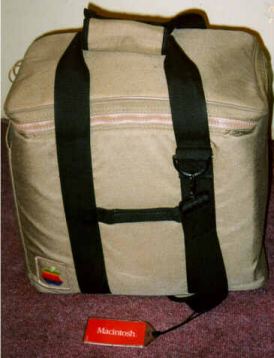The Macintosh turns 25 (and how it was almost a Bicycle)

Tomorrow, 24 January 2009, is the 25th anniversary of the Macintosh. On that fateful day in 1984 Apple released a little toaster of a personal computer that went on to become the first commercially successful personal computer to feature a mouse and a graphical user interface.
The embedded video above (YouTube) is Apple's famous "1984" television commercial directed by film maker Ridley Scott. From my new book, Corporations that Changed the World: Apple Inc.:Apple announced the Macintosh to the world with a television commercial (“1984”) that was directed by Ridley Scott, an alumnus of such films as Alien, Blade Runner, and Gladiator. The commercial, written by Apple’s advertising agency Chiat /Day, aired on January 22, 1984, during Super Bowl XVIII between the Washington Redskins and the Los Angeles Raiders. The ad featured a female character (played by Anya Major) wearing a white tank top, red shorts, and running shoes, running through an eerie, dark, futuristic world and throwing a sledgehammer at a huge TV image of Big Brother. The Big Brother character was giving orders to rows of people that looked like prisoners— a veiled reference to IBM. The commercial ended with a message read by Edward Grover: “On January 24, Apple Computer will introduce Macintosh. And you’ll see why 1984 won’t be like 1984.”
Here's another fun "Macintosh" anecdote by The Father of the Macintosh, Andy Hertzfeld, again from Corporations:
How the Mac Was Almost a Bicycle
The name Macintosh was originally selected because it was Jef Raskin’s favorite type of apple, but the Mac almost wasn’t an Apple at all. When Raskin took a leave of absence in February 1981, Steve Jobs and Rod Holt made the decision to change Apple to something else. They felt that the name Macintosh was just a code name and that a name change was in order to reflect the change in regime.Holt decided on Bicycle as the new name that would replace Raskin’s Macintosh for the duration of the project and presented it to his design team. When they balked, Holt insisted that all references to Macintosh be changed to Bicycle, telling them that it shouldn’t really matter “since it was only a code name.” The Bicycle name originated from an ad that Apple had placed in Scientific American magazine. The ad featured quotes from Steve Jobs about computers, including one about how personal computers were “bicycles for the mind.” The logic was that humans could run as fast as other species, but a human—on a bicycle—could beat them all. Rod’s edict was never obeyed. Somehow, Macintosh just seemed right.
 My story goes like this: I received a 128k Mac in the summer of 1984 as a birthday gift from my Mom and spent an entire summer at my grandparents cottage obsessively learning MacWrite and MacPaint. The rest, as they say, is history.
My story goes like this: I received a 128k Mac in the summer of 1984 as a birthday gift from my Mom and spent an entire summer at my grandparents cottage obsessively learning MacWrite and MacPaint. The rest, as they say, is history.
I remember attending an early Macworld Expo (1985?) where the smell of solder was wafting down the hotel hallway from all the backroom Mac 512k upgrades that were being performed. I still have a working 128k in the garage (in the original beige Apple bag, natch) and a MacPortable in the attic, although it's not the backlit one.
What's your Mac story? Tell us about your Mac museum in the TalkBack. (C'mon, you know you have one. :)
Aside: Fun BBC video of a Mac 128k booting faster than a modern Windows notebook.
Update: CNet's Caroline McCarthy wrote a nice story about the anniversary that's part of a package called Mac at 25 from News.com.